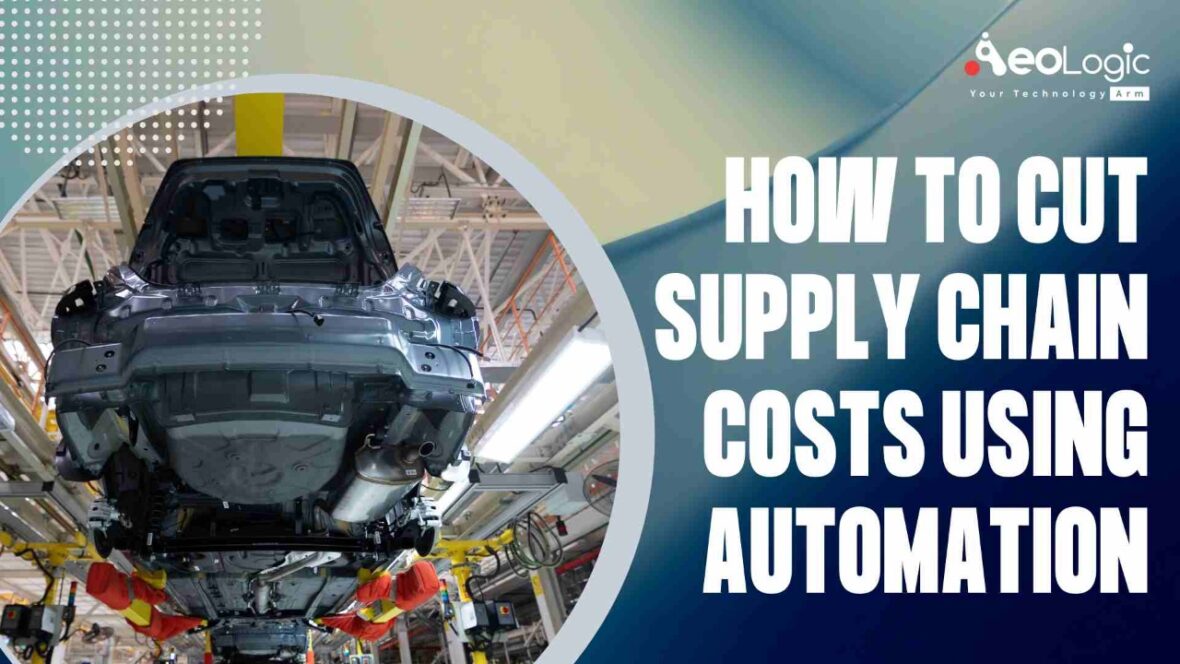As the number of businesses operating online continues to increase, so does the importance of cutting costs. There are many ways to reduce costs, including outsourcing, automation, and using technology. Many companies spend a lot of time and effort manually managing the supply chain process from receiving products from suppliers to shipping them out to customers. But what if you could cut these costs dramatically? What if you could automate the most important tasks in your supply chain so that you don’t need to hire additional staff to do the work? This blog post discusses how to cut supply chain costs using automation. We’ll show you how to automate the most important tasks in your warehouse or distribution center and how to save money by doing so.
The cost of selling goods is often the most significant expense for a company (COGS). These costs include the cost of raw materials, transportation, and inventory. The goal of any business is to minimize these costs. There are a number of ways that companies can cut costs in this area, but one of the most effective ways to do so is to automate as much of the supply chain process as possible.
Let’s begin!
Table of contents
- What is automation in the supply chain?
- Why Automation Matters in Supply Chain
- How Automation Matters in Supply Chain
- How Automation Cut Down the Cost of Supply Chain
- Conclusion
What is automation in the supply chain?
Most companies have a supply chain that consists of multiple steps that need to happen in order to get a product from its original manufacturer to the hands of a consumer. These steps can include manufacturing, shipping, warehousing, and fulfillment. In order to run an efficient and effective supply chain, you’ll need to be able to automate as many of these steps as possible. This is especially true for companies that have a high number of products or a high volume of sales.
“Supply chain automation is a very powerful tool for increasing efficiency and reducing costs.”
Supply chain automation is one of the most exciting areas of business today. The supply chain is a complex network of people, processes, and systems that move products from the manufacturer to the retailer. The supply chain is critical to the success of any business. It’s also a significant expense centre for companies.
Also Read: Information Technology to Support the New Values of the EV
Why Automation Matters in Supply Chain
Automation is a key factor in improving the time and cost of managing supply chains, especially for companies that have a complex network of suppliers. Automated tools can help improve efficiency in many ways, including by analyzing data to help identify problems or opportunities for improvement, reducing and simplifying tasks, reducing errors, and minimizing manual work.
Also Read: Why Is CRM Software a Game-changer When It Comes to Delivering Better Customer Experiences?
How Automation Matters in Supply Chain
Warehouse Automation
Warehouse automation in the supply chain is helpful to manage the flow of goods and reduce labor costs. It is a solution used by logistics companies to increase efficiency, eliminate manual processes and optimize workflow.
Companies can automate their warehouses using systems such as conveyor belts, vision-guided robots, and automated storage and retrieval systems (ASRS). These robots are highly effective in sorting packages and quickly locating items.
Warehouse automation solutions help companies to achieve their goals and their systems help companies to overcome the shortage of workers. Furthermore, operations in warehouses include repetitive tasks like inventory management, supply chain tracking, and doing dangerous high-risk jobs, such as operating heavy equipment. Automating such tasks helps achieve more productivity for firms, worker safety is also improved, sustainability is encouraged and costs in lowered as well.
Boost your business performance with our automation solutions!
Even though there are still many businesses who have not implemented warehouse automation today, the market size will double to $30 billion by 2026
Also Read: Why Is CRM Software a Game-changer When It Comes to Delivering Better Customer Experiences?
Automation in the Back Office
Automation has a substantial positive impact on back-office tasks. Delivery orders, dock receipts, bills of lading (B/L), and maritime waybills are just a few examples of the various papers used in supply chain management procedures.
For a variety of reasons, employees in the supply chain department regularly store and process these papers, but doing so manually takes a lot of time and prevents firms from achieving operational excellence.
Businesses can achieve practically end-to-end document automation using optical character recognition (OCR) and artificial intelligence (AI) (involving tasks like data capture, understanding information on the document, and sending the document to the relevant person).
RPA improves supply chain back-office tasks. 44% of global organizations surveyed expect RPA to disrupt supply chains by 2023. They said RPA implementation can boost supply chain productivity and efficiency. Supply chain leaders should integrate RPA into their back-office processes.
Also Read: Importance of Digital Asset Management in the Retail Industry
Automation in the Transportation Sector
When it comes to logistics, road transport reigns supreme. Your kitchen cupboards are stocked almost entirely with goods that travel to them via truck. The truck driver shortage that currently plagues the road transport industry is only expected to get worse in the years ahead.
This problem of a lack of truck drivers can be solved by implementing transport automation. More and more executives at supply chain companies are putting resources into transport automation. Forecasts place the value of the autonomous vehicle market at $11 billion by 2028, up from an estimated $1.6 billion in 2021. In the network, supplies can be transported using autonomous things like trucks and drones.
Automated Transport Examples: To stay ahead of the curve and find a solution to the driver shortage problem, Amazon is investing heavily in autonomous self-driving truck systems and trucks.
Also Read: How Technology Is Changing the Future of Logistics
How Automation Cut Down the Cost of Supply Chain
When supply chain processes are automated, less work needs to be done by hand to run a business. It makes supply chain managers more productive, accurate, and efficient. Choosing the right tools and partners can also cut down on logistics costs, boost profits, and protect your business with a strong supply chain that can adapt to changing economic conditions.
Also Read: The Role & Benefits of ERP in Supply Chain Management
Track Customer Demand
The inventory management system should track customer demand. Demand is continually fluctuating, thus manual tracking isn’t possible. The correct inventory and order management software uses real-time data to monitor inventory levels and incoming client orders.
Effective inventory systems calculate typical daily sales, lead time, and inventory levels, including safety stock and reorder points, and use past data to alter these amounts when sales trend. Hence, this will ensure that products are accessible to satisfy client demand and that excess inventory never affects your earnings or costs. Legacy supply chain models and systems track this manually, resulting in erroneous data and wasted opportunity.
Also Read: The Role & Benefits of ERP in Supply Chain Management
Fix supply chain weaknesses
Automating your supply chain helps you locate slow, broken, or unnecessary parts. Your supply chain is hazy. So, there are several processes from supplier to client for a product. Flexible supply chains help you maintain a competitive advantage, cut costs, and optimize sourcing and procurement.
In supply chain network, products and raw materials are tracked from the time you place an order with your primary supplier until it reaches the client. Using the precise data produced during this process, supply chain managers can discover costly parts of your supply chain.
Also Read: Importance of Digital Asset Management in the Retail Industry
Simplify the Ordering Procedure
Your supply chain plan needs to run smoothly and efficiently.
To avoid any manual errors, products, and raw materials can be barcoded or RFID-tagged. To make sure you know what you have and where it is, they must then be traced as they move through your whole supply chain.
All areas of your supply chain organization must have access to this data in order for the proper choices to be made along the way. From product development, manufacturing, and supply chain partners to logistics service providers. Only if an inventory system offers end-to-end order visibility that enables real-time supply chain flexibility will it be effective. And a flexible supply network effectively maintains costs low and the satisfaction of supply chain executives.
Also Read: Importance of Digital Asset Management in the Retail Industry
Increase Performance
If you aren’t monitoring your progress, you won’t know where you’ve been. It will be easier for you to steer your company in the proper direction if you keep an eye on your key performance indicators.
You can make realistic goals and decide the steps necessary to achieve them by keeping your warehouse KPIs in mind. Without a future-oriented strategy, bad turns and ill-informed choices can eat into revenues and drive up costs.
Also Read: The Role of AI in Education And Learning: Just Promises Or Revolution
Conclusion
Automation has always been a way for businesses to save money. It’s not just a convenience. It is a must in our modern digital world.
Hence, there are many ways to reduce the cost of shipping. One way is to make sure that your customers receive their products on time and at the right price. To do this, you need to have a good inventory management system in place. By automating the tasks involved in inventory management, you can free up your time and focus on what you do best—building your business.
If you want to keep and improve your business’s competitive edge, contact the Aeologic team to get started on your business journey.
FAQ’s
What are the different types of automation?
There are two main categories of automation: batch processing and continuous processing. Batch processing involves the use of computers to run through large amounts of data in one step. Continuous processing involves the use of computers to run through small amounts of data over and over again.
How can businesses cut costs with automation?
Businesses can cut costs by automating their supply chain processes. For example, they can automate the process of receiving orders, processing orders, and shipping items.
What are the different types of automation?
There are two main categories of automation: batch processing and continuous processing. Batch processing involves the use of computers to run through large amounts of data in one step. Continuous processing involves the use of computers to run through small amounts of data over and over again.
How does automation work?
When you use automation, you set up a program and then tell the computer what to do. Hence, the computer will perform the tasks and send you results.
Related Blogs:






